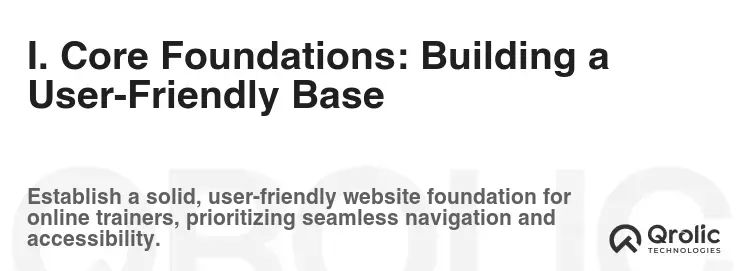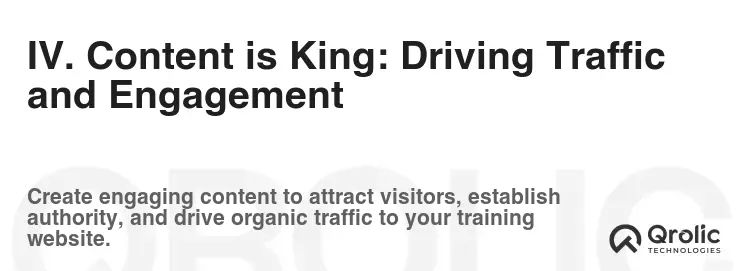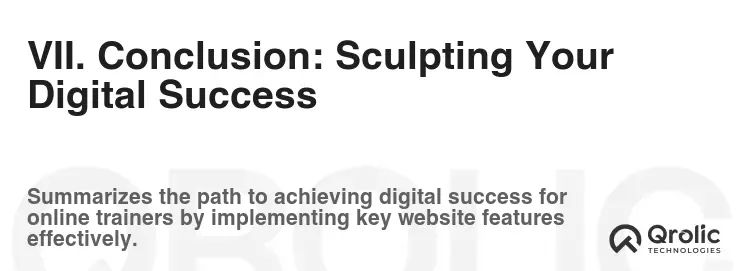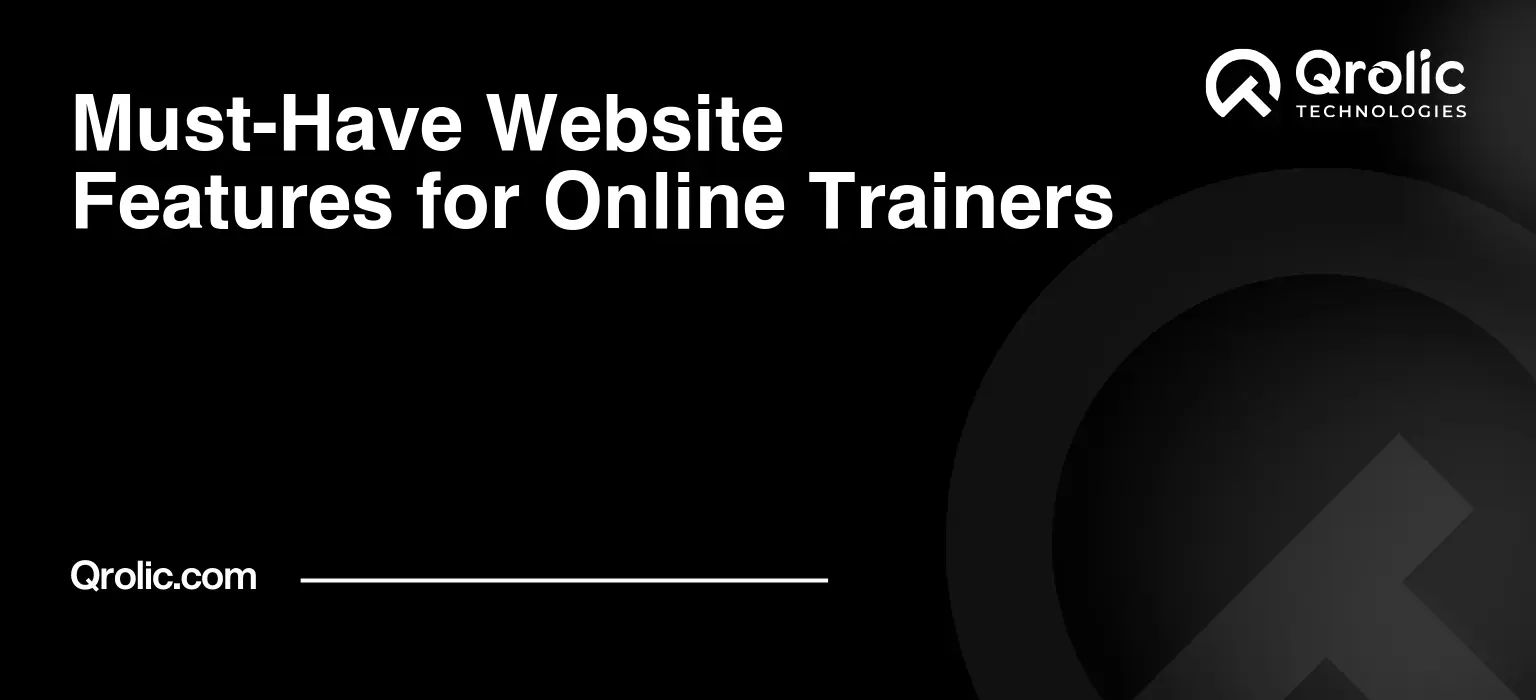The online fitness industry is booming. Are you ready to sculpt your digital presence?
In the digital age, a strong online presence is no longer optional for online trainers; it’s essential for survival and success. Your website is your virtual gym, your digital storefront, and your primary tool for attracting and retaining clients. But simply having a website isn’t enough. To truly stand out and thrive in this competitive landscape, your website needs to be equipped with features that not only meet the needs of your clients but also elevate their experience and streamline your business operations. This comprehensive guide will delve deep into the must-have website features for online trainers, providing you with the knowledge and actionable strategies to build a website that attracts, engages, and converts potential clients into loyal followers.
Quick Summary:
- Build a fast, secure, mobile-friendly website.
- Showcase programs with great visuals and testimonials.
- Integrate scheduling, payments, and email marketing.
- Create valuable content and optimize for search.
Table of Contents
- I. Core Foundations: Building a User-Friendly Base
- A. Mobile-First Design: Reaching Clients on the Go
- B. Fast Loading Speed: Keeping Clients Engaged
- C. Clear and Concise Navigation: Guiding Clients Effortlessly
- D. Secure Website (HTTPS): Building Trust and Credibility
- II. Showcasing Your Expertise: Service Pages that Convert
- A. Detailed Program Descriptions: Painting a Clear Picture
- B. High-Quality Photos and Videos: Show, Don’t Just Tell
- C. Client Testimonials and Success Stories: Building Trust and Social Proof
- D. Clear Pricing and Packages: Transparency Builds Confidence
- III. Streamlining Operations: Essential Website Integrations
- A. Schedule Integration: Simplifying Booking and Management
- B. Payment Gateway Integration: Secure and Convenient Transactions
- C. Email Marketing Integration: Nurturing Leads and Building Relationships
- D. CRM Integration: Managing Client Relationships Effectively
- IV. Content is King: Driving Traffic and Engagement
- A. Blog: Sharing Valuable Fitness Tips and Advice
- B. Free Resources: Attracting Leads and Building Trust
- C. Success Stories: Inspiring Potential Clients
- V. SEO Optimization: Making Your Website Discoverable
- A. Keyword Research: Understanding What Your Audience is Searching For
- B. On-Page Optimization: Optimizing Your Website Content
- C. Off-Page Optimization: Building Authority and Backlinks
- VI. Qrolic Technologies: Your Partner in Digital Fitness
- VII. Conclusion: Sculpting Your Digital Success
I. Core Foundations: Building a User-Friendly Base

Before diving into the advanced features, let’s establish the core foundations of a successful online trainer website. These elements are non-negotiable and crucial for creating a positive first impression and a seamless user experience.
A. Mobile-First Design: Reaching Clients on the Go
Why it’s crucial: The vast majority of online users browse the internet on their mobile devices. If your website isn’t optimized for mobile, you’re alienating a significant portion of your potential client base.
What it means: Mobile-first design prioritizes the mobile experience, ensuring that your website is responsive, visually appealing, and easy to navigate on smartphones and tablets. This includes:
- Responsive Layout: Your website should automatically adjust to fit any screen size, preventing users from having to zoom in or scroll horizontally.
- Optimized Images: Images should be compressed for faster loading times on mobile devices.
- Touch-Friendly Navigation: Buttons and links should be large enough to be easily tapped on a touchscreen.
- Simplified Content: Mobile users often have shorter attention spans, so content should be concise and easy to read.
Actionable Steps:
- Test your website’s mobile responsiveness: Use Google’s Mobile-Friendly Test to check how your website performs on mobile devices.
- Choose a mobile-responsive theme or template: When building your website, select a theme or template that is specifically designed for mobile.
- Prioritize mobile content: Create content that is easily digestible on mobile devices, such as short paragraphs, bullet points, and engaging visuals.
B. Fast Loading Speed: Keeping Clients Engaged
Why it’s crucial: In today’s fast-paced world, users expect websites to load quickly. A slow-loading website can lead to frustration, abandonment, and a negative impression of your brand.
What it means: Loading speed refers to the time it takes for your website to fully load in a user’s browser. Ideally, your website should load in under 3 seconds. Factors that can affect loading speed include:
- Image Size: Large, unoptimized images can significantly slow down your website.
- Website Code: Cluttered or poorly written code can also impact loading speed.
- Server Response Time: The speed of your web hosting server can also affect how quickly your website loads.
Actionable Steps:
- Test your website’s loading speed: Use tools like Google PageSpeed Insights or GTmetrix to identify areas for improvement.
- Optimize your images: Compress your images using tools like TinyPNG or ImageOptim.
- Minify your website code: Remove unnecessary characters and spaces from your HTML, CSS, and JavaScript files.
- Choose a fast web hosting provider: Select a web hosting provider with a proven track record of speed and reliability.
- Implement browser caching: Browser caching allows users’ browsers to store static files, reducing the need to download them every time they visit your website.
C. Clear and Concise Navigation: Guiding Clients Effortlessly
Why it’s crucial: Your website’s navigation should be intuitive and easy to use. Visitors should be able to quickly find the information they’re looking for without getting lost or confused.
What it means: Clear and concise navigation involves organizing your website’s content in a logical and user-friendly manner. This includes:
- Simple Menu Structure: Use a clear and concise menu structure with easily understandable labels.
- Consistent Navigation: Ensure that your navigation is consistent across all pages of your website.
- Search Functionality: Provide a search bar so users can quickly find specific information.
- Clear Calls to Action: Use clear and prominent calls to action to guide users towards desired actions, such as signing up for a consultation or purchasing a program.
Actionable Steps:
- Plan your website’s structure: Before building your website, create a sitemap that outlines the main pages and their relationships.
- Use clear and descriptive labels: Use labels that accurately reflect the content of each page.
- Limit the number of menu items: Avoid overwhelming users with too many menu options.
- Test your navigation: Ask friends or colleagues to navigate your website and provide feedback.
D. Secure Website (HTTPS): Building Trust and Credibility
Why it’s crucial: Security is paramount in today’s digital landscape. A secure website protects your clients’ data and builds trust in your brand.
What it means: HTTPS (Hypertext Transfer Protocol Secure) is a secure version of HTTP that encrypts data transmitted between a user’s browser and your website. This prevents eavesdropping and protects sensitive information, such as passwords and credit card details.
Actionable Steps:
- Obtain an SSL certificate: Purchase an SSL certificate from a reputable provider.
- Install the SSL certificate on your web server: Follow your web hosting provider’s instructions for installing the SSL certificate.
- Update your website’s settings: Ensure that your website is configured to use HTTPS.
- Regularly update your website’s security protocols: Stay up-to-date with the latest security updates to protect your website from vulnerabilities.
II. Showcasing Your Expertise: Service Pages that Convert

Your service pages are the heart of your online trainer website. They’re where you showcase your expertise, explain your offerings, and convince potential clients to invest in your services.
A. Detailed Program Descriptions: Painting a Clear Picture
Why it’s crucial: Potential clients need to understand exactly what they’re getting when they purchase a program. Vague or incomplete descriptions can lead to confusion and lost sales.
What it means: Detailed program descriptions should provide a comprehensive overview of your programs, including:
- Program Goals: Clearly state the goals of the program, such as weight loss, muscle gain, or improved fitness.
- Target Audience: Identify the ideal client for the program, such as beginners, intermediate, or advanced athletes.
- Program Structure: Explain the structure of the program, including the duration, frequency, and types of workouts.
- Required Equipment: List any equipment that clients will need to participate in the program.
- Nutritional Guidance: Describe the nutritional guidance that is included in the program.
- Support and Accountability: Explain the level of support and accountability that clients will receive, such as email support, coaching calls, or access to a private online community.
- Pricing and Payment Options: Clearly state the price of the program and the available payment options.
Actionable Steps:
- Use clear and concise language: Avoid jargon and technical terms that clients may not understand.
- Use visuals: Include images and videos to showcase the program and its benefits.
- Highlight the benefits: Focus on the benefits that clients will receive from the program, such as improved health, increased energy, or a better physique.
- Address potential concerns: Anticipate potential concerns that clients may have and address them in the program description.
- Include testimonials: Add testimonials from satisfied clients to build trust and credibility.
B. High-Quality Photos and Videos: Show, Don’t Just Tell
Why it’s crucial: Visuals are a powerful way to engage potential clients and showcase your expertise. High-quality photos and videos can help clients visualize themselves working with you and achieving their fitness goals.
What it means: High-quality photos and videos should be:
- Professionally shot: Consider hiring a professional photographer or videographer to capture high-quality images and videos.
- Well-lit and clear: Ensure that your photos and videos are well-lit and clear, with sharp focus and vibrant colors.
- Relevant to your brand: Choose visuals that are consistent with your brand’s aesthetic and messaging.
- Engaging and inspiring: Use visuals that are engaging and inspiring, showcasing your personality and your clients’ success stories.
Actionable Steps:
- Invest in professional photography and videography: Don’t rely on low-quality photos or videos.
- Showcase your personality: Include photos and videos that show you working with clients, demonstrating exercises, or sharing your fitness journey.
- Feature client success stories: Showcase client success stories with before-and-after photos and videos.
- Use visuals to explain your programs: Use videos to demonstrate exercises, explain program structures, or provide nutritional guidance.
- Optimize your visuals for the web: Compress your images and videos to reduce file size and improve loading speed.
C. Client Testimonials and Success Stories: Building Trust and Social Proof
Why it’s crucial: Client testimonials and success stories are powerful forms of social proof. They show potential clients that your programs are effective and that you’re a trustworthy trainer.
What it means: Client testimonials and success stories should be:
- Authentic and genuine: Avoid using fake or embellished testimonials.
- Specific and detailed: Encourage clients to share specific details about their experience and results.
- Relatable and inspiring: Choose testimonials that are relatable and inspiring to your target audience.
- Visible and prominent: Display testimonials prominently on your website, such as on your service pages, homepage, and landing pages.
Actionable Steps:
- Ask satisfied clients for testimonials: Reach out to clients who have achieved positive results and ask them to share their experience.
- Make it easy for clients to leave testimonials: Provide a form or email address where clients can submit their testimonials.
- Include photos and videos with testimonials: Ask clients to provide photos or videos that showcase their results.
- Feature testimonials from different types of clients: Include testimonials from clients with different goals, backgrounds, and fitness levels.
- Regularly update your testimonials: Add new testimonials as you receive them to keep your website fresh and relevant.
D. Clear Pricing and Packages: Transparency Builds Confidence
Why it’s crucial: Potential clients need to know how much your services cost before they can make a decision. Transparency in pricing builds confidence and reduces hesitation.
What it means: Clear pricing and packages should:
- Clearly state the price of each program or service: Avoid hidden fees or ambiguous pricing.
- Explain what is included in each package: Specify the services and features that are included in each package.
- Offer different package options: Provide different package options to cater to different budgets and needs.
- Offer flexible payment options: Offer flexible payment options, such as monthly installments or subscription plans.
- Make it easy to purchase: Provide a clear and straightforward process for purchasing your programs or services.
Actionable Steps:
- Research your competitors’ pricing: Understand how your pricing compares to that of other online trainers.
- Value your services appropriately: Price your services based on the value you provide, your experience, and your expertise.
- Offer discounts or promotions: Consider offering discounts or promotions to attract new clients or incentivize existing clients to upgrade their packages.
- Clearly state your cancellation policy: Be transparent about your cancellation policy to avoid misunderstandings.
- Provide a money-back guarantee: Consider offering a money-back guarantee to reduce risk and build trust.
III. Streamlining Operations: Essential Website Integrations

Your website should not only attract clients but also streamline your business operations. Integrating key tools and platforms can save you time, improve efficiency, and enhance the client experience.
A. Schedule Integration: Simplifying Booking and Management
Why it’s crucial: Managing your schedule manually can be time-consuming and prone to errors. Schedule integration automates the booking process, allowing clients to easily book sessions and manage their appointments.
What it means: Schedule integration involves connecting your website to a scheduling platform, such as Acuity Scheduling, Calendly, or Google Calendar. This allows clients to:
- View your availability: See your available time slots and book sessions that fit their schedule.
- Book appointments online: Book appointments directly through your website without having to contact you manually.
- Receive automated reminders: Receive automated reminders about upcoming appointments.
- Manage their appointments: Reschedule or cancel appointments online.
Actionable Steps:
- Choose a scheduling platform: Research different scheduling platforms and choose one that meets your needs and budget.
- Integrate the scheduling platform with your website: Follow the instructions provided by the scheduling platform to integrate it with your website.
- Customize your scheduling settings: Set your availability, pricing, and appointment types.
- Test the integration: Ensure that the integration is working properly by booking a test appointment.
- Promote your online booking system: Let your clients know that they can book appointments online through your website.
B. Payment Gateway Integration: Secure and Convenient Transactions
Why it’s crucial: Secure and convenient payment processing is essential for online businesses. Payment gateway integration allows you to accept payments online through your website, making it easier for clients to purchase your programs and services.
What it means: Payment gateway integration involves connecting your website to a payment gateway, such as Stripe, PayPal, or Square. This allows you to:
- Accept credit card payments: Accept credit card payments securely through your website.
- Process payments automatically: Automate the payment processing process, saving you time and effort.
- Track your sales: Track your sales and revenue through your payment gateway’s dashboard.
- Manage refunds and cancellations: Easily process refunds and cancellations.
Actionable Steps:
- Choose a payment gateway: Research different payment gateways and choose one that meets your needs and budget.
- Integrate the payment gateway with your website: Follow the instructions provided by the payment gateway to integrate it with your website.
- Set up your payment settings: Configure your payment settings, such as your currency and payment methods.
- Test the integration: Ensure that the integration is working properly by processing a test payment.
- Secure your website: Implement security measures to protect your clients’ payment information.
C. Email Marketing Integration: Nurturing Leads and Building Relationships
Why it’s crucial: Email marketing is a powerful tool for nurturing leads, building relationships with clients, and promoting your services. Email marketing integration allows you to collect email addresses through your website and send targeted email campaigns to your subscribers.
What it means: Email marketing integration involves connecting your website to an email marketing platform, such as Mailchimp, ConvertKit, or AWeber. This allows you to:
- Collect email addresses: Collect email addresses through opt-in forms on your website.
- Segment your audience: Segment your audience based on their interests, demographics, and behavior.
- Send targeted email campaigns: Send targeted email campaigns to your subscribers, such as newsletters, promotional offers, and educational content.
- Automate your email marketing: Automate your email marketing efforts with automated email sequences.
- Track your email performance: Track your email performance, such as open rates, click-through rates, and conversions.
Actionable Steps:
- Choose an email marketing platform: Research different email marketing platforms and choose one that meets your needs and budget.
- Integrate the email marketing platform with your website: Follow the instructions provided by the email marketing platform to integrate it with your website.
- Create opt-in forms: Create opt-in forms to collect email addresses on your website.
- Segment your audience: Segment your audience based on their interests and demographics.
- Create engaging email campaigns: Create engaging email campaigns that provide value to your subscribers.
D. CRM Integration: Managing Client Relationships Effectively
Why it’s crucial: A Customer Relationship Management (CRM) system helps you manage your client relationships, track interactions, and provide personalized service. CRM integration allows you to connect your website to a CRM platform, streamlining your client management process.
What it means: CRM integration involves connecting your website to a CRM platform, such as HubSpot, Salesforce, or Zoho CRM. This allows you to:
- Capture leads automatically: Automatically capture leads from your website and add them to your CRM.
- Track client interactions: Track all interactions with your clients, such as emails, calls, and appointments.
- Manage client data: Manage client data in a centralized location.
- Automate tasks: Automate tasks, such as sending welcome emails or scheduling follow-up calls.
- Personalize your service: Personalize your service based on each client’s individual needs and preferences.
Actionable Steps:
- Choose a CRM platform: Research different CRM platforms and choose one that meets your needs and budget.
- Integrate the CRM platform with your website: Follow the instructions provided by the CRM platform to integrate it with your website.
- Configure your CRM settings: Configure your CRM settings, such as your lead capture forms and automation rules.
- Train your team: Train your team on how to use the CRM effectively.
- Regularly update your CRM data: Keep your CRM data up-to-date to ensure accurate client information.
IV. Content is King: Driving Traffic and Engagement

High-quality content is essential for driving traffic to your website, engaging your audience, and establishing yourself as an authority in the online fitness industry.
A. Blog: Sharing Valuable Fitness Tips and Advice
Why it’s crucial: A blog allows you to share valuable fitness tips and advice with your audience, attracting new visitors to your website and establishing yourself as a trusted source of information.
What it means: Your blog should feature:
- Regularly updated content: Publish new blog posts on a regular basis to keep your audience engaged.
- High-quality, informative content: Provide valuable information that is relevant to your target audience.
- Engaging writing style: Use an engaging writing style that captures your audience’s attention.
- SEO optimization: Optimize your blog posts for search engines to improve your website’s visibility.
Actionable Steps:
- Develop a content strategy: Plan your blog content in advance, identifying topics that are relevant to your audience and align with your business goals.
- Write engaging blog posts: Write blog posts that are informative, engaging, and easy to read.
- Optimize your blog posts for SEO: Use relevant keywords in your blog posts, optimize your images, and build backlinks to your website.
- Promote your blog posts: Promote your blog posts on social media and through email marketing.
- Engage with your readers: Respond to comments and questions from your readers.
B. Free Resources: Attracting Leads and Building Trust
Why it’s crucial: Offering free resources, such as ebooks, workout guides, or meal plans, is a great way to attract leads, build trust, and showcase your expertise.
What it means: Free resources should be:
- Valuable and relevant: Provide valuable information that is relevant to your target audience.
- High-quality: Ensure that your free resources are well-written, professionally designed, and free of errors.
- Easy to access: Make it easy for visitors to download your free resources.
- Lead magnets: Use your free resources as lead magnets to collect email addresses.
Actionable Steps:
- Identify your target audience’s needs: Determine what types of resources your target audience would find valuable.
- Create high-quality free resources: Create free resources that are well-written, professionally designed, and easy to access.
- Promote your free resources: Promote your free resources on your website, social media, and through email marketing.
- Use your free resources as lead magnets: Collect email addresses in exchange for access to your free resources.
- Follow up with your leads: Follow up with your leads to nurture them and convert them into paying clients.
C. Success Stories: Inspiring Potential Clients
Why it’s crucial: Sharing client success stories is a powerful way to inspire potential clients, build trust, and showcase the effectiveness of your programs.
What it means: Success stories should be:
- Authentic and genuine: Avoid using fake or embellished success stories.
- Specific and detailed: Encourage clients to share specific details about their experience and results.
- Relatable and inspiring: Choose success stories that are relatable and inspiring to your target audience.
- Visible and prominent: Display success stories prominently on your website, such as on your service pages, homepage, and landing pages.
Actionable Steps:
- Ask satisfied clients for success stories: Reach out to clients who have achieved positive results and ask them to share their experience.
- Make it easy for clients to leave success stories: Provide a form or email address where clients can submit their success stories.
- Include photos and videos with success stories: Ask clients to provide photos or videos that showcase their results.
- Feature success stories from different types of clients: Include success stories from clients with different goals, backgrounds, and fitness levels.
- Regularly update your success stories: Add new success stories as you receive them to keep your website fresh and relevant.
V. SEO Optimization: Making Your Website Discoverable

Even the most beautifully designed and feature-rich website will be ineffective if potential clients can’t find it. SEO (Search Engine Optimization) is the process of optimizing your website to rank higher in search engine results pages (SERPs), increasing its visibility and driving organic traffic.
A. Keyword Research: Understanding What Your Audience is Searching For
Why it’s crucial: Keyword research helps you understand what terms your target audience is using to search for online trainers and fitness programs. By targeting these keywords in your website content, you can improve your website’s ranking in search results.
What it means: Keyword research involves:
- Identifying relevant keywords: Brainstorming a list of keywords that are relevant to your business and target audience.
- Analyzing keyword search volume: Using keyword research tools to determine how many people are searching for each keyword.
- Assessing keyword competition: Evaluating the competition for each keyword to determine how difficult it will be to rank for that keyword.
- Selecting the right keywords: Choosing keywords that are relevant to your business, have a high search volume, and have a low competition.
Actionable Steps:
- Brainstorm a list of relevant keywords: Think about the terms that your target audience would use to search for online trainers and fitness programs.
- Use keyword research tools: Use tools like Google Keyword Planner, SEMrush, or Ahrefs to analyze keyword search volume and competition.
- Target long-tail keywords: Long-tail keywords are longer, more specific phrases that have a lower search volume but are also less competitive.
- Use keywords naturally in your content: Avoid keyword stuffing, which can harm your website’s ranking.
B. On-Page Optimization: Optimizing Your Website Content
Why it’s crucial: On-page optimization involves optimizing your website content to make it more search engine friendly. This includes:
- Title tags: Optimizing your title tags to include relevant keywords.
- Meta descriptions: Writing compelling meta descriptions that encourage users to click on your website in search results.
- Header tags: Using header tags (H1, H2, H3, etc.) to structure your content and highlight important keywords.
- Image alt tags: Adding alt tags to your images to describe the images to search engines.
- Internal linking: Linking to other relevant pages on your website.
- URL structure: Using clear and concise URLs that include relevant keywords.
Actionable Steps:
- Optimize your title tags: Write title tags that are concise, descriptive, and include relevant keywords.
- Write compelling meta descriptions: Write meta descriptions that accurately describe the content of each page and encourage users to click.
- Use header tags to structure your content: Use header tags to break up your content into logical sections and highlight important keywords.
- Add alt tags to your images: Add alt tags to your images to describe the images to search engines.
- Link to other relevant pages on your website: Use internal linking to connect related content and improve your website’s navigation.
- Use clear and concise URLs: Use URLs that are easy to understand and include relevant keywords.
C. Off-Page Optimization: Building Authority and Backlinks
Why it’s crucial: Off-page optimization involves building your website’s authority and reputation by earning backlinks from other websites. Backlinks are links from other websites to your website. Search engines see backlinks as a vote of confidence, and the more backlinks your website has, the higher it will rank in search results.
What it means: Off-page optimization involves:
- Building relationships with other websites: Connecting with other websites in your industry and building relationships with their owners or editors.
- Creating valuable content: Creating content that other websites will want to link to.
- Guest blogging: Writing guest posts for other websites in your industry.
- Participating in online communities: Participating in online communities and forums and sharing your expertise.
- Submitting your website to directories: Submitting your website to relevant online directories.
Actionable Steps:
- Create valuable content: Create content that is informative, engaging, and shareable.
- Reach out to other websites: Contact other websites in your industry and offer to write a guest post or contribute to their content.
- Participate in online communities: Participate in online communities and forums and share your expertise.
- Submit your website to directories: Submit your website to relevant online directories.
- Monitor your backlinks: Monitor your backlinks to ensure that they are from high-quality websites.
VI. Qrolic Technologies: Your Partner in Digital Fitness

Building and maintaining a successful online trainer website can be a complex and time-consuming task. That’s where Qrolic Technologies comes in. We are a full-service digital agency specializing in helping businesses like yours thrive in the online world.
How Qrolic Technologies Can Help You:
- Website Design and Development: We create stunning, mobile-responsive websites that are tailored to your brand and business goals.
- SEO Optimization: We help you improve your website’s ranking in search results, driving more organic traffic to your site.
- Content Marketing: We create engaging and informative content that attracts leads, builds trust, and establishes you as an authority in your industry.
- Social Media Marketing: We help you build a strong social media presence, engage with your audience, and generate leads.
- PPC Advertising: We create and manage effective PPC advertising campaigns that drive targeted traffic to your website.
Ready to take your online training business to the next level? Contact Qrolic Technologies today for a free consultation!
Website: https://qrolic.com/
VII. Conclusion: Sculpting Your Digital Success

In conclusion, a well-designed and feature-rich website is essential for online trainers who want to thrive in the digital age. By implementing the must-have features outlined in this guide, you can create a website that attracts, engages, and converts potential clients into loyal followers. Remember to prioritize mobile-first design, fast loading speed, clear navigation, and security. Showcase your expertise with detailed program descriptions, high-quality visuals, and client testimonials. Streamline your operations with schedule integration, payment gateway integration, email marketing integration, and CRM integration. Drive traffic and engagement with a blog, free resources, and success stories. And finally, optimize your website for SEO to make it discoverable to potential clients. With dedication, strategic planning, and the right tools, you can sculpt your digital success and build a thriving online training business.






